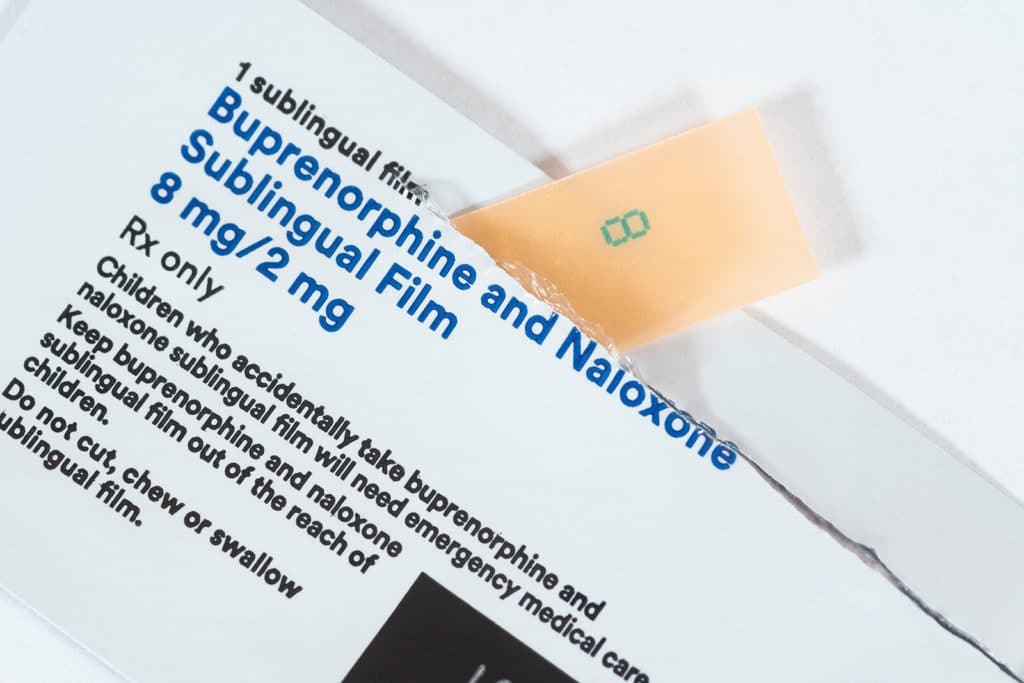Are you considering starting a treatment program for your opioid use disorder that involves taking SUBOXONE®? SUBOXONE® is a medication that’s used to treat the cravings and withdrawal symptoms that individuals experience after ceasing their opioid of choice. SUBOXONE® is comprised of buprenorphine and naloxone. It is administered as a dissolvable film or tablet that is put under the tongue. Let’s take a look at how SUBOXONE® helps individuals recover from opioid use disorder and some of the common side effects.
Table of Contents
What is SUBOXONE®?
SUBOXONE® is a medication that is commonly used to treat opioid use disorder. It is comprised of buprenorphine and naloxone. Buprenorphine is a synthetic opioid that is FDA approved to opioid dependency and severe pain. When it’s used to treat opioid use disorder, the medication is taken in place of the individual’s preferred drug. For this reason, SUBOXONE® is considered an agonist substitution treatment.

Naloxone is an FDA-approved medication that reverses opioid overdoses by binding to the opioid receptors in the brain. This makes it an opioid antagonist because once the naloxone has bound itself to the opioid receptors in the brain, other opioids cannot attach to those receptors.
When Subuxone is combined with therapy and counseling, it helps individuals recover from opioid use disorder.
Common Side Effects of SUBOXONE®
SUBOXONE® may cause a few side effects. The most common include:
- Blurry vision
- Difficulty concentrating or thinking
- Dizziness
- Fainting
- Feeling exhausted or fatigued
- Having a numb mouth
- Headaches
- Insomnia or difficulty sleeping
- Red mouth
- Slurred speech
- Sweating
- Tongue pain
- Upset stomach, nausea and vomiting
Serious Side Effects and Warning Signs
Some of the side effects of taking SUBOXONE® are considered serious and may be life-threatening. If any of these symptoms present themselves, the individual should seek prompt medical treatment.
Difficulty Breathing or Slower than Normal Breathing
If the individual starts having difficulty breathing or is breathing slower than normal, it’s time to see a doctor. This symptom may be accompanied by blurry vision, slurred speech, dizziness and fainting.
Signs of Liver Problems
Individuals who are taking SUBOXONE® should be aware of the signs of liver damage. These can include dark urine, a yellowing of the skin or jaundice, and stomach pain. If any of these symptoms develop, the individuals should seek medical treatment.
Signs of Adrenal Gland Problems
The adrenal glands help regulate blood pressure, metabolism, immune system function and blood sugar. Signs that the adrenal glands are not functioning properly include vomiting, nausea, fatigue and loss of appetite.
Signs of an Allergic Reaction
In some cases, individuals may be allergic to the ingredients in SUBOXONE®. Signs of an allergic reaction include rashes, hives, difficulty breathing and swelling. If an individual who is taking SUBOXONE® experiencing any of these symptoms, they should seek medical treatment.

Long-Term Side Effects
Individuals who are prescribed SUBOXONE® for opioid use disorder should be slowly tapered off of the medication as they advance through treatment. Long-term use of the medication can lead to dependency and misuse. Long-term side effects include:
- Experiencing breathing problems
- Falling into a coma
- Reduced cortisol levels
- Liver damage
- Mental health problems
- Sexual dysfunction
Problems Breathing and Comas
Taking high doses of SUBOXONE® can lead to depressed breathing. This risk increases if the individual mixes SUBOXONE® with another drug, medication or alcohol. Individuals who already have breathing problems may be at an increased risk for this side effect.
Reduced Hormone Levels
Taking SUBOXONE® for long periods of time can interfere with the body’s ability to produce cortisol. Cortisol is the hormone that’s responsible for your body’s response to stress. It also helps regulate the metabolism, suppress inflammation and regulate blood pressure. Low levels of cortisol can lead to fatigue, weight loss, loss of appetite and low blood pressure. Individuals may also experience an increase in depression and anxiety symptoms.
Liver Damage
SUBOXONE® is processed by the liver. Long-term use may cause liver damage. If jaundice or yellowing of the skin is noticed, individuals should seek immediate medical treatment. To help avoid liver damage, your medical provider may perform regular blood tests.
Mental Health Issues
Long-term use of SUBOXONE® or misuse of SUBOXONE® can lead to an increase in mood swings and changes in the individual’s personality. Individuals may also experience an increase in symptoms of anxiety and depression. Changes in mental well-being should be monitored and reported to a doctor.
Sexual Dysfunction
Some individuals report sexual dysfunction while taking SUBOXONE®. Symptoms can include a lack of sexual desire, problems getting and maintaining an erection and premature ejaculation.

Interactions with Other Drugs
SUBOXONE® may interact with other drugs and medications. SUBOXONE® should not be combined with alcohol, benzodiazepines, central nervous system depressants or other opioids. Additionally, SUBOXONE® should not be taken with muscle relaxers, certain seizure medications and antipsychotics. Combining SUBOXONE® with other drugs and medications may increase the risk of an overdose.
Precautions and Considerations
Individuals who have been prescribed SUBOXONE® should tell their doctor about all the medications they are currently taking and any medical conditions they have. Some conditions, including Addison’s disease, enlarged prostate, problems urinating, mental health issues, tooth problems, adrenal and thyroid gland problems, and liver, kidney and gallbladder problems may impact your ability to take SUBOXONE®. Additionally, individuals who have preexisting conditions that impact their ability to breathe may not be suitable candidates for SUBOXONE® treatment.
Individuals who plan on becoming pregnant or breastfeeding their infants should tell their medical team about their SUBOXONE® usage. Pregnant women may need more pain medication during birth, and their babies may experience withdrawal symptoms directly after birth. Additionally, SUBOXONE® can be passed to the infant in breast milk.
Lastly, it’s important for individuals to understand how SUBOXONE® affects them before driving or operating heavy equipment or power tools. SUBOXONE® has been known to cause drowsiness and delayed reaction times.
Alternatives to SUBOXONE®
If SUBOXONE® isn’t recommended to treat opioid use disorder, there are other medications available, including naltrexone and methadone.
Naltrexone
For individuals who wish to avoid using an opioid agonist, Naltrexone may be a good choice. Naltrexone is not a controlled substance, which means it can be prescribed and given in any setting. It’s a long-acting formulation, and there’s no risk of overdosing by taking Naltrexone. It also has the added benefit of being able to treat alcoholism and opioid use disorder.
Naltrexone also has a few drawbacks. It cannot be started at the beginning of the detox phase. Instead, the individual must be partially or fully detoxed. Naltrexone is also not recommended for pregnant women.
Methadone
Methadone is another alternative to SUBOXONE®. It is a full opioid antagonist and a controlled substance. For this reason, it can only be dispensed by a licensed opioid treatment program. However, the benefits of taking Methadone for opioid use disorder are numerous. Taking Methadone can increase the overall odds of survival. It can help individuals stay in treatment longer, and it helps decrease overall opioid use.
Methadone has a few downsides. It can be hard to access, and there can be a stigma surrounding its use. Individuals may also find it hard to wean off of the medication.

Conclusion
SUBOXONE® can help individuals stop their illicit opioid use, especially when the medication is combined with other treatments, like counseling and therapy. If SUBOXONE® treatment sounds right for you, it’s important to talk to your healthcare provider. Once you’ve been accepted into a SUBOXONE® treatment program, it’s important to talk to your healthcare team about any changes in your physical or mental health and undergo any needed tests in order to maintain your health.
If you’re ready to take the first step in your recovery, contact Illinois Recovery Center in Swansea. We offer medical detox.
To learn more, call us Today!
References
- https://www.samhsa.gov/medications-substance-use-disorders/medications-counseling-related-conditions/buprenorphine
- https://www.health.harvard.edu/blog/5-myths-about-using-suboxone-to-treat-opiate-addiction-2018032014496
- https://adf.org.au/drug-facts/buprenorphine/
- https://psychiatry.uams.edu/clinical-care/cast/buprenorphine/
- https://www.suboxone.com
- https://www.ncbi.nlm.nih.gov/books/NBK459126/#:~:text=Buprenorphine%20is%20FDA%2Dapproved%20for,opioid%20(such%20as%20heroin).
- https://www.samhsa.gov/medications-substance-use-disorders/medications-counseling-related-conditions/naloxone
- https://my.clevelandclinic.org/health/articles/22187-cortisol
- https://www.healthline.com/health/drugs/suboxone-interactions
- https://www.asam.org/docs/default-source/education-docs/alternatives-to-buprenorphine.pdf?sfvrsn=371f4bc2_0
SUBOXONE® is a registered trademark of Indivior UK Limited. IRC is not affiliated with Indivior UK Limited or its affiliates (“Indivior”), and any reference to it or its intellectual property is for informational purposes only and is not endorsed or sponsored by Indivior.



